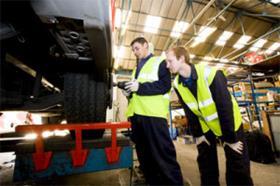The new apprenticeship levy will come into play on 6 April and will change the way the industry funds and trains its apprentices.
Having led the industry’s bid for its own trailblazer apprenticeship, RHA deputy director of policy Colin Snape marks National Apprenticeship Week for Motortransport.co.uk by outlining the top five things operators need to know about the tax and how to use it.
1. What is the levy?
The apprenticeship levy will be a levy on UK employers to fund training and assessment from 6 April 2017.
It will give employers more influence over how apprenticeships are designed and paid for, so that they focus on the skills, knowledge and behaviours required.
The levy will be 0.5% of the pay bill in excess of £3m, paid through PAYE. Any UK employer with an annual pay bill of more than £3m is liable to pay the levy.
Employers in England who pay the levy will be able to get out more than they pay in, through a 10% top-up to their digital accounts.
2. Who will pay what?

There are two types of employers that will be required to contribute outside the levy towards the cost of their apprenticeships training – those that haven’t paid into the levy and those that have used all the funds in their digital accounts.
If a levy-paying employer doesn’t have sufficient funds in its digital account to pay for the training and assessment costs in a particular month; the government will pay 90% of the difference between the amount due and the amount of funds available in the digital account.
The employer will be responsible for paying 10% of the costs.
Employers with fewer than 50 employees will not have to make any contributions. Employers with more than 50 employees, which do not meet the £3m threshold, can access funded apprenticeships at the same 90%/10% rate.
3. The English system
The amount entering an employer’s English digital apprenticeship service account will reflect what it has available to spend through the English system.
The RHA plans to give the same proportion of a firm’s levy payment to spend in England as the proportion of its pay bill paid to employees living in England.
For example: if 100% of a firm’s pay bill is in England, 100% of its levy payment is in the digital account.

If 80% of a firm’s pay bill is in England, 80% of its levy payment is in a digital account. The full amount of the levy will be deducted but cannot be used for employees based in the devolved nations.
As education and training is a devolved policy, each of the UK nations manage their own programmes and have their own arrangements for supporting employers to access and pay for apprenticeships.
At this time the devolved nations have not decided how to use the levy money and so it will not be available.
4. What can funds be used for?
Funds can be used for apprenticeship training and assessment with an approved training provider and assessment organisation up to its funding band maximum.
Funds cannot be used for:
■ wages
■ statutory licences to practise
■ travel and subsistence costs
■ managerial costs
■ traineeships
■ work placement programmes
■ the costs of setting up an apprenticeship programme
5. What to do next?
Plan an apprenticeship programme as soon as possible
■ register the company for the digital apprenticeship service
■ choose an apprenticeship training provider (the RHA can provide advice for members);
■ choose an end-point assessor organisation;
■ look to recruit apprentices either by advertisement or use an apprenticeship training agency;
■ manage funds and training providers in a digital account.
There are three standards available: HGV driver; warehouse operative; and traffic office operative.
Current staff can also go through an apprenticeship scheme.
By Colin Snape














